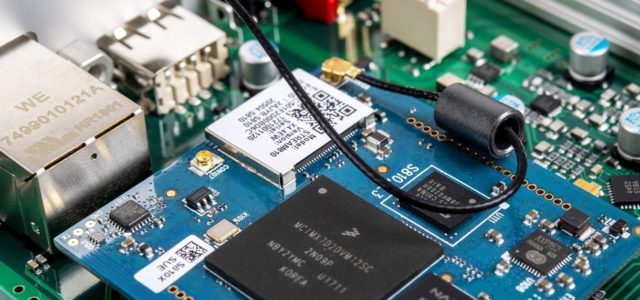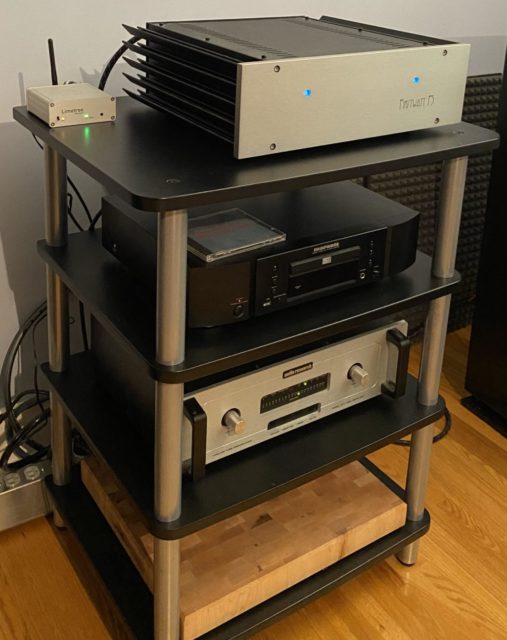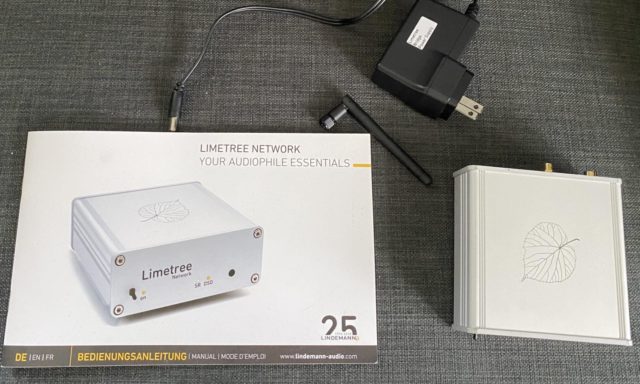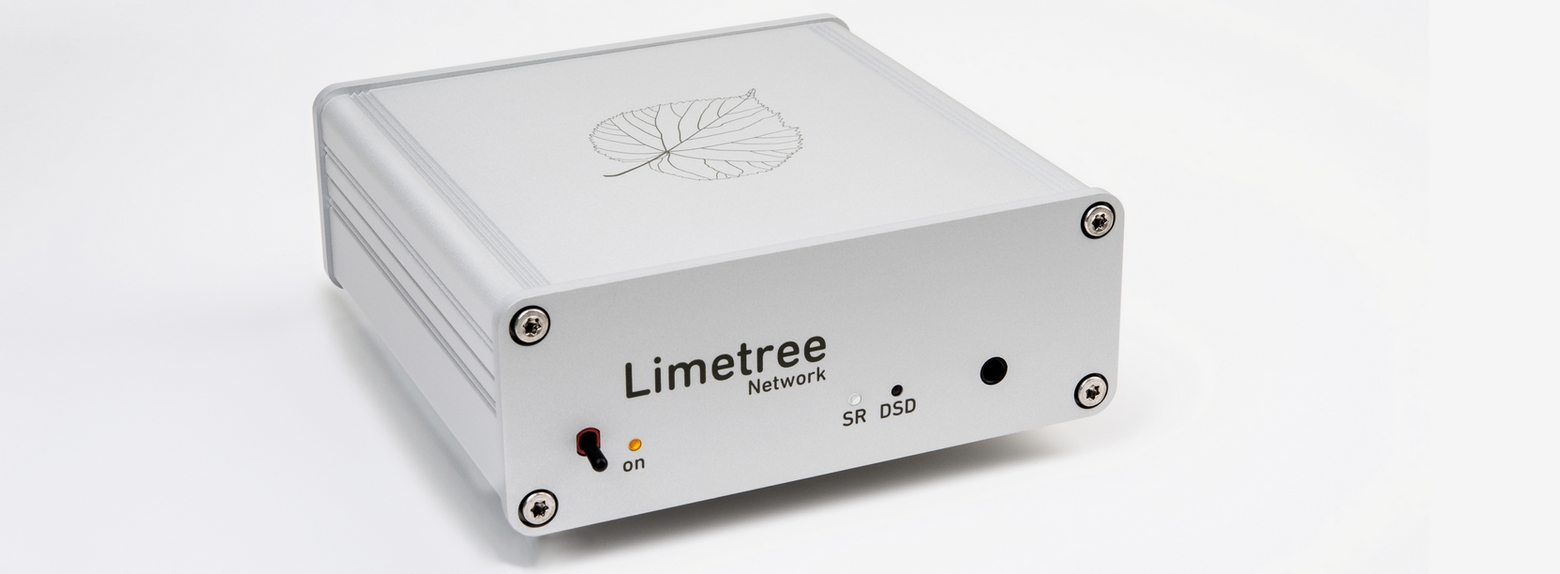As I unboxed this diminutive offering from the renowned German firm Lindemann, the words of Clara Peller echoed, thus, in my trivia-soaked mind: ‘where’s the beef?’ I should have remembered that other firms like Canada’s Resonessence Labs offer world-class products in pint-sized casings. I own one such product–their Herus DAC/headphone amp. Right off the bat, even as I profess my continuing love for my portable Herus/iPhone combination, I’ll say that the Limetree Network smokes the Herus, making it seem congested and fuzzy by comparison. The Limetree sports a quiet, powerful, world-class headphone amp section which propelled my Beyerdynamic DT880s, 770s and HiFiMan 400s to perform at a level higher than even my beloved Bottlehead Crack.
 For those of us tempted by over-engineered, 25 to 50 pound DACs from DENAFRIPS, made in China and stuffed with literally several hundred or even thousands of parts, the European-made Limetree series of products will not appeal–at first glance. But don’t judge this feather-weighted, parts-shy product on looks alone. The Lindemann Limetree Network is the Manny Pacquiao of network streaming DACs. Small, light, fast as lightning, agile, with the ability to shock with bursts of power. It’s a knock out!
For those of us tempted by over-engineered, 25 to 50 pound DACs from DENAFRIPS, made in China and stuffed with literally several hundred or even thousands of parts, the European-made Limetree series of products will not appeal–at first glance. But don’t judge this feather-weighted, parts-shy product on looks alone. The Lindemann Limetree Network is the Manny Pacquiao of network streaming DACs. Small, light, fast as lightning, agile, with the ability to shock with bursts of power. It’s a knock out!
Lindemann’s Limetree series of products also includes a network streamer without a DAC (named Bridge), a phono preamp (Phono), and a headphone amp (Headphone). Each product is an example of trickle down technology for the middle classes. Lindemann states on its website: “Sometimes less is more. A large number of parts and big enclosures are no guarantee for good sound. In most cases the opposite is true. The continuing miniaturization in the field of electronics enables small, but fine products which keep getting more efficient.” Anyone who has heard Accuphase’s small, parts-shy modular DAC, which slides into the back of the company’s integrated amplifiers and preamps, knows that world-class sound need not entail hundreds of capacitors and resistors. The Limetree Network weighs in at under one pound and it measures just 4.2 by 4.2 by 1.6 inches. It costs $960 USD. Thanks to the long-established audio store The Gramophone of Edmonton, Alberta, I had a chance to contemplate my music for a few weeks under the spell of a Limetree.
In the paucity of parts, the Limetree resembles Graham Slee or First Watt products. You’re paying for the design, for the circuit, perhaps the quality of the parts, and perhaps for the enclosure. You’re also paying for European labor. The Limetree differs in that its paucity of parts is packed into a particularly petite enclosure. But I’d venture to say that the profit margins on the Limetree are considerably less than on, say, my Graham Slee Era Gold Mark IV phono amp (with a higher price and much cheaper components). Under the Limetree’s tiny hood there’s a MEMS Femto Clock and two AK4452 DAC chips. Another AK chip, the 4137, handles the re-sampling. This explains some of the price tag. The Limetree has an On/Off toggle switch and a 3.5 mm headphone jack on the front. An LED will light up in one of seven colours, depending on the bit rate at play. I listened to redbook 16/44.1 and to DSD 256. At the back, you’ll find a set of RCA output jacks, WLAN and USB stick input, and a LAN connection. A ‘medical grade’ wall wart is your small, light power supply. The Limetree is Roon ready, and it supports Tidal, Spotify, Qobuz, Deezer and internet radio. It handles dual-band WiFi and Bluetooth 4.2 (not 5.0).
Listening Impressions
 The Limetree is clear, articulate, and resolute compared with my MHDT Labs Paradisea+, a Non Oversampling DAC using the Phillips TDA1545A chip. My MHDT Labs might be likened to one Eric Esch (aka Butterbean). The Paradisea is big, round, fat, jovial and comparatively sluggish in the ring, but capable of convincing swings of power, albeit ones that are telescoped and don’t emerge suddenly from a black background. The Limetree is more neutral and more accurate given its lower noise floor and lack of a tube buffer. The Limetree is not as dense and moist as the MHDT Labs–it’s vivid, linear, resolving. It’s not warm but it’s not bright. It sounds closer to my Musical Paradise D-1 DAC, but with much more thrust and detail retrieval. It’s slightly crisp, but without fatiguing digititis. No frequency is stressed. Compared with my Marantz SA15S2 Ken Ishiwata Special Edition CD/SACD player, the Limetree is quicker and more incisive. Techno beats and electronic gimmicks of all sorts are clearly more defined with the Limetree. The Marantz is to the warm side of neutral and is tonally richer, but it’s slower, with less PraT than the Limetree. Objectively speaking, the Limetree is probably more ‘accurate’ than the Marantz house style, which emphasizes warmth.
The Limetree is clear, articulate, and resolute compared with my MHDT Labs Paradisea+, a Non Oversampling DAC using the Phillips TDA1545A chip. My MHDT Labs might be likened to one Eric Esch (aka Butterbean). The Paradisea is big, round, fat, jovial and comparatively sluggish in the ring, but capable of convincing swings of power, albeit ones that are telescoped and don’t emerge suddenly from a black background. The Limetree is more neutral and more accurate given its lower noise floor and lack of a tube buffer. The Limetree is not as dense and moist as the MHDT Labs–it’s vivid, linear, resolving. It’s not warm but it’s not bright. It sounds closer to my Musical Paradise D-1 DAC, but with much more thrust and detail retrieval. It’s slightly crisp, but without fatiguing digititis. No frequency is stressed. Compared with my Marantz SA15S2 Ken Ishiwata Special Edition CD/SACD player, the Limetree is quicker and more incisive. Techno beats and electronic gimmicks of all sorts are clearly more defined with the Limetree. The Marantz is to the warm side of neutral and is tonally richer, but it’s slower, with less PraT than the Limetree. Objectively speaking, the Limetree is probably more ‘accurate’ than the Marantz house style, which emphasizes warmth.
Could I live with the Limetree as my only DAC? Absolutely. Sure, it lacks my middle-aged Marantz’s mid-range weight (flabbiness?) but in other categories it’s better. It’s like my ARC LS-17 preamp: straight ahead, neutral, fast, slightly airy or holographic. It’s quiet, accurate and fast. Pair it with dark speakers like Harbeth Compact 7s and it would likely be a perfect match. With my Harbeth Super HL5+, the Limetree could sometimes be a tad bright. No matter: a flick of the switch of my Primaluna Dialogue Premium integrated amp, and we enter triode mode. Surely the 6L6 in triode mode is one of the most underrated tubes. With my Primaluna decked out with 6L6s from TAD or with 7581As from Tung Sol, the Limetree was perfect with the Super HL5+. Upstairs, where the Tekton Lores currently reside, it was a perfect pairing with an ARC LS-17 and First Watt F5. With my slower single-ended pentode tube amps, the Limetree injected a welcome dose of speed and resolution.
 To my ears, and with my speakers, the Limetree Network favoured rock and classical music over jazz. Glenn Gould’s recording of the Emperor Concerto with Stokowski revealed a good sense of layering and soundstage depth. The strings can be a bit bleached on this classic recording, and the Limetree will not hide or ‘correct’ this sort of original sin. But the tiny box’s ability to keep the pace with complex music was immediately apparent. For those who like a heavy dollop of warmth or romance with their acoustic music or jazz, this likely isn’t your ideal streaming DAC. But if you like Radioactivity (“it’s in the air, for you and me!”), that old Kraftwerk ditty with ridiculously juvenile lyrics but fascinating artificial sounds, you’ll probably like this DAC/streamer. The Limetree excels at detail retrieval and the unlayering of electronic music. Echo, reverb, decay–you’ll get a high dose with Radioactivity. Cheesy synth, Fender Rhodes, Wurlitzer, Moog, Mellotron–they sound fantastic with the Limetree. It tilts the work of Marc Cary and Azymuth away from golden warmth and further into the deep, swirling electric wormhole of their minds. Shirley Scott’s organ on Stanley Turrentine’s “A Good Egg” is fully raspy and Joshua Redman’s sax on “Trios Live” is delightfully reedy. The plaintive wails and weeps of Jeff Beck’s guitar in “Live at Ronnie Scott’s” is spooky. With the Limetree’s clarity, we get a good sense of the imperfect concert venue. Cymbals sound a bit tinny, but that might be the recording and the bad acoustics of the London jazz bar.
To my ears, and with my speakers, the Limetree Network favoured rock and classical music over jazz. Glenn Gould’s recording of the Emperor Concerto with Stokowski revealed a good sense of layering and soundstage depth. The strings can be a bit bleached on this classic recording, and the Limetree will not hide or ‘correct’ this sort of original sin. But the tiny box’s ability to keep the pace with complex music was immediately apparent. For those who like a heavy dollop of warmth or romance with their acoustic music or jazz, this likely isn’t your ideal streaming DAC. But if you like Radioactivity (“it’s in the air, for you and me!”), that old Kraftwerk ditty with ridiculously juvenile lyrics but fascinating artificial sounds, you’ll probably like this DAC/streamer. The Limetree excels at detail retrieval and the unlayering of electronic music. Echo, reverb, decay–you’ll get a high dose with Radioactivity. Cheesy synth, Fender Rhodes, Wurlitzer, Moog, Mellotron–they sound fantastic with the Limetree. It tilts the work of Marc Cary and Azymuth away from golden warmth and further into the deep, swirling electric wormhole of their minds. Shirley Scott’s organ on Stanley Turrentine’s “A Good Egg” is fully raspy and Joshua Redman’s sax on “Trios Live” is delightfully reedy. The plaintive wails and weeps of Jeff Beck’s guitar in “Live at Ronnie Scott’s” is spooky. With the Limetree’s clarity, we get a good sense of the imperfect concert venue. Cymbals sound a bit tinny, but that might be the recording and the bad acoustics of the London jazz bar.
 With Steve Swallow and Wolfgang Muthspiel’s “Simple Songs,” I noticed a large difference switching between Triode and Ultralinear modes on my Primaluna amp. Two other DACs used in this review–the Musical Paradise D-1 and the MHDT Labs Paradisea+, cannot scrape up enough detail to reveal those differences. Comparing the Limetree to my much pricier Marantz disc spinner, I noticed that the tiny box excelled with spatial cues, air, and detail, but couldn’t flesh out Muthspiel’s tonal colours to the same degree. It was good enough, but not stellar. The Marantz has a bit more bloom in the midrange, but that’s the only way in which I find it superior. With Peter Tosh’s “Pick Myself Up,” there’s no contest: the tiny Limetree dishes out copious quantities of gorgeous, deep, dry bass. The Marantz seems a bit bloated in comparison. The Jamaican all-female reggae band, Adahzeh, has an unknown gem of a song, “Island Girl.” It’s a delightfully impish track packed with hilarious lyrics, but the recording is congested. Streaming from Tidal to my other DACs, the song is a bit of a sonic mess. But the Limetree sorts it out and makes it somewhat listenable, probably because it can make sense of the overbearing bass line and find a place for the other instruments too.
With Steve Swallow and Wolfgang Muthspiel’s “Simple Songs,” I noticed a large difference switching between Triode and Ultralinear modes on my Primaluna amp. Two other DACs used in this review–the Musical Paradise D-1 and the MHDT Labs Paradisea+, cannot scrape up enough detail to reveal those differences. Comparing the Limetree to my much pricier Marantz disc spinner, I noticed that the tiny box excelled with spatial cues, air, and detail, but couldn’t flesh out Muthspiel’s tonal colours to the same degree. It was good enough, but not stellar. The Marantz has a bit more bloom in the midrange, but that’s the only way in which I find it superior. With Peter Tosh’s “Pick Myself Up,” there’s no contest: the tiny Limetree dishes out copious quantities of gorgeous, deep, dry bass. The Marantz seems a bit bloated in comparison. The Jamaican all-female reggae band, Adahzeh, has an unknown gem of a song, “Island Girl.” It’s a delightfully impish track packed with hilarious lyrics, but the recording is congested. Streaming from Tidal to my other DACs, the song is a bit of a sonic mess. But the Limetree sorts it out and makes it somewhat listenable, probably because it can make sense of the overbearing bass line and find a place for the other instruments too.
 Sometimes, however, it was a case of sonic garbage in, sonic garbage out: some of ELO’s brilliant oeuvre was not recorded brilliantly, and the Limetree reminds us of that while playing “Turn to Stone.” It’s just too bleached and bright. But that’s not the general theme with the Limetree. In keeping true to the source, it doesn’t polish sonic turds. I’m intrigued by the German electronica group Monolake, even as I wonder how history will judge this sort of artificial ‘music.’ Electronica is a guilty pleasure, one I long resisted. John Darko’s 10 volume “Electronica for Audiophiles” series on his webzine has been my guide as I venture forth into this genre. An old college friend with eclectic musical tastes recently turned me on to Amon Tobin’s oeuvre. What a treasure! Tobin’s “Pale Forms Run By” is an incongruously named track drenched in Fender Rhodes-like warmth. Nothing pale on display here! The Limetree is now warm and fully fleshed out. It’s true to the source.
Sometimes, however, it was a case of sonic garbage in, sonic garbage out: some of ELO’s brilliant oeuvre was not recorded brilliantly, and the Limetree reminds us of that while playing “Turn to Stone.” It’s just too bleached and bright. But that’s not the general theme with the Limetree. In keeping true to the source, it doesn’t polish sonic turds. I’m intrigued by the German electronica group Monolake, even as I wonder how history will judge this sort of artificial ‘music.’ Electronica is a guilty pleasure, one I long resisted. John Darko’s 10 volume “Electronica for Audiophiles” series on his webzine has been my guide as I venture forth into this genre. An old college friend with eclectic musical tastes recently turned me on to Amon Tobin’s oeuvre. What a treasure! Tobin’s “Pale Forms Run By” is an incongruously named track drenched in Fender Rhodes-like warmth. Nothing pale on display here! The Limetree is now warm and fully fleshed out. It’s true to the source.
Lindemann app
 Speaking of your sources, the Limetree interface and app work well, but are not without occasional glitches and idiosyncrasies. Setup was quick and easy. I used WLAN, Bluetooth and LAN (briefly, using my third system consisting of Mordant Short Carnival 2s and a Musical Paradise amp just to see how it worked). If you plug the Limetree straight into an ethernet port (LAN), it’s entirely smooth sailing, no glitches. Alas, my router is located in a small room 30 feet from my ‘reference system’, so 95% of my listening was over WLAN and Bluetooth. After listening for dozens of hours while I was upstairs working on the computer and the kids were on their PS4 or Nintendo Switch, it’s clear to me that this device wants little competition for WiFi bandwidth. At least if you have a three year-old router, albeit one that was top-of-the-line when purchased. Alone in the house, there was never a glitch while streaming–finding songs on Tidal and switching between tracks was flawless. But when the WiFi had two or three other users, there were occasional skips, drop-outs, and lags in switching songs. You might consider investing in a new router if you have an older one and/or you live in a large house. The Bluetooth function worked flawlessly with my iPhone, but the drop in sound quality compared to streaming full resolution Tidal over a WLAN network was noticeable. With no competition for the router’s attention, the Limetree using WLAN proved very powerful. Once, while listening to three different versions of “Riviera Paradise” over Tidal, including those by Stevie Ray Vaughan, Steve Hunter and Stanley Jordan, I went upstairs with my phone in pocket. My phone and the Limetree did not fail to communicate even though they were separated vertically by one floor and horizontally by at least 30 feet. It was only after the three songs had concluded that I realized I had left the Limetree’s vicinity.
Speaking of your sources, the Limetree interface and app work well, but are not without occasional glitches and idiosyncrasies. Setup was quick and easy. I used WLAN, Bluetooth and LAN (briefly, using my third system consisting of Mordant Short Carnival 2s and a Musical Paradise amp just to see how it worked). If you plug the Limetree straight into an ethernet port (LAN), it’s entirely smooth sailing, no glitches. Alas, my router is located in a small room 30 feet from my ‘reference system’, so 95% of my listening was over WLAN and Bluetooth. After listening for dozens of hours while I was upstairs working on the computer and the kids were on their PS4 or Nintendo Switch, it’s clear to me that this device wants little competition for WiFi bandwidth. At least if you have a three year-old router, albeit one that was top-of-the-line when purchased. Alone in the house, there was never a glitch while streaming–finding songs on Tidal and switching between tracks was flawless. But when the WiFi had two or three other users, there were occasional skips, drop-outs, and lags in switching songs. You might consider investing in a new router if you have an older one and/or you live in a large house. The Bluetooth function worked flawlessly with my iPhone, but the drop in sound quality compared to streaming full resolution Tidal over a WLAN network was noticeable. With no competition for the router’s attention, the Limetree using WLAN proved very powerful. Once, while listening to three different versions of “Riviera Paradise” over Tidal, including those by Stevie Ray Vaughan, Steve Hunter and Stanley Jordan, I went upstairs with my phone in pocket. My phone and the Limetree did not fail to communicate even though they were separated vertically by one floor and horizontally by at least 30 feet. It was only after the three songs had concluded that I realized I had left the Limetree’s vicinity.
Conclusion
The Lindemann app piggybacks on top of Tidal, in that you access Tidal through the Lindemann app. The interface is not as intuitive as Tidal’s, and it adds one or two additional steps for each search function to find the precise song or album. One can search in Tidal via the Lindemann app, but one cannot add a song to one’s Tidal Favourite list. You’ll have to exit the Lindemann app and go to Tidal to do that. These issues exist with other streamers. With these small caveats aside, having returned the Lindemann Limetree to the distributor, I realize how much I miss it and now wonder if I should purchase one for myself. The Limetree Network is small, it won’t clutter up your life, and it can sound magical with the right ancillary gear. Highly recommended.


Nice review. You have been missed.
Good morning,
I read your review about the Limetree Network I with great attention. I purchased it recently and my first days with it were not so encouraging. I used it on a vintage system (Kef 104ab + Yamaha CA810) and it was too analytic and dry sounding, spoiling the warmth of the vintage Kefs and the natural dynamic sound of the Yamaha.
But then I tried it on my main system and it sounded totally differently. I paired it with Harbeth Compact 7 XD, A Primaluna Dialogue two with 6L6GC old from General Electric’s. It is still very detailed and precise but it participates more to the cohesion of the system. I agree on a preference for electronic music, rock and single instruments (Anouar Brahem, Nils Frahm) and voices. Jazz sounds a bit more thin and empty, less rich, cosy, and warm (I like it more romantic and velvet) than played on my Naim CD5i.
I found quite surprising that you mentionned the gear I am actually using and I believe we do agree on the feeling about this streamer.
Best wishes
Hi Dimitri, thanks for sharing your experience.
All the best,
Noam
Hello , i am on the market right now for a streaming dac in the 1500$ range…got to choose between the lindemann limetree discuss here & the Innuos pulse mini…can’t listen to the limetree in my area…which one of these 2 would you go for ? i just want to start streaming Tidal with the best possible sound..thanks !
Hi Stephane,
I can say that the Bluesound Node and Audiolab 6000N Play are nice options below $1k.
Noam